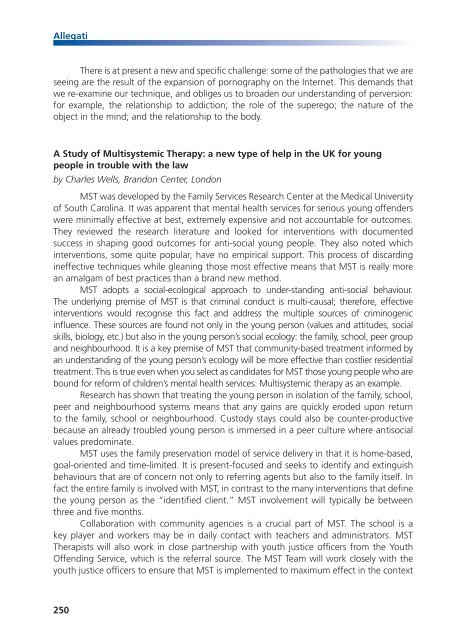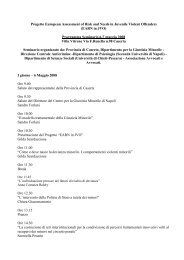Scarica il documento - Dipartimento per la Giustizia Minorile
Scarica il documento - Dipartimento per la Giustizia Minorile
Scarica il documento - Dipartimento per la Giustizia Minorile
You also want an ePaper? Increase the reach of your titles
YUMPU automatically turns print PDFs into web optimized ePapers that Google loves.
allegati<br />
there is at present a new and specific challenge: some of the pathologies that we are<br />
seeing are the result of the expansion of pornography on the internet. this demands that<br />
we re-examine our technique, and obliges us to broaden our understanding of <strong>per</strong>version:<br />
for example, the re<strong>la</strong>tionship to addiction; the role of the su<strong>per</strong>ego; the nature of the<br />
object in the mind; and the re<strong>la</strong>tionship to the body.<br />
a study of multisystemic therapy: a new type of help in the uK for young<br />
people in trouble with the <strong>la</strong>w<br />
by Charles Wells, Brandon Center, London<br />
Mst was developed by the Fam<strong>il</strong>y services research Center at the Medical university<br />
of south Carolina. it was apparent that mental health services for serious young offenders<br />
were minimally effective at best, extremely expensive and not accountable for outcomes.<br />
they reviewed the research literature and looked for interventions with documented<br />
success in shaping good outcomes for anti-social young people. they also noted which<br />
interventions, some quite popu<strong>la</strong>r, have no empirical support. this process of discarding<br />
ineffective techniques wh<strong>il</strong>e gleaning those most effective means that Mst is really more<br />
an amalgam of best practices than a brand new method.<br />
Mst adopts a social-ecological approach to under-standing anti-social behaviour.<br />
the underlying premise of Mst is that criminal conduct is multi-causal; therefore, effective<br />
interventions would recognise this fact and address the multiple sources of criminogenic<br />
influence. these sources are found not only in the young <strong>per</strong>son (values and attitudes, social<br />
sk<strong>il</strong>ls, biology, etc.) but also in the young <strong>per</strong>son’s social ecology: the fam<strong>il</strong>y, school, peer group<br />
and neighbourhood. it is a key premise of Mst that community-based treatment informed by<br />
an understanding of the young <strong>per</strong>son’s ecology w<strong>il</strong>l be more effective than costlier residential<br />
treatment. this is true even when you select as candidates for Mst those young people who are<br />
bound for reform of ch<strong>il</strong>dren’s mental health services: Multisystemic therapy as an example.<br />
research has shown that treating the young <strong>per</strong>son in iso<strong>la</strong>tion of the fam<strong>il</strong>y, school,<br />
peer and neighbourhood systems means that any gains are quickly eroded upon return<br />
to the fam<strong>il</strong>y, school or neighbourhood. Custody stays could also be counter-productive<br />
because an already troubled young <strong>per</strong>son is immersed in a peer culture where antisocial<br />
values predominate.<br />
Mst uses the fam<strong>il</strong>y preservation model of service delivery in that it is home-based,<br />
goal-oriented and time-limited. it is present-focused and seeks to identify and extinguish<br />
behaviours that are of concern not only to referring agents but also to the fam<strong>il</strong>y itself. in<br />
fact the entire fam<strong>il</strong>y is involved with Mst, in contrast to the many interventions that define<br />
the young <strong>per</strong>son as the “identified client.” Mst involvement w<strong>il</strong>l typically be between<br />
three and five months.<br />
Col<strong>la</strong>boration with community agencies is a crucial part of Mst. the school is a<br />
key p<strong>la</strong>yer and workers may be in da<strong>il</strong>y contact with teachers and administrators. Mst<br />
therapists w<strong>il</strong>l also work in close partnership with youth justice officers from the Youth<br />
offending service, which is the referral source. the Mst team w<strong>il</strong>l work closely with the<br />
youth justice officers to ensure that Mst is implemented to maximum effect in the context<br />
250





